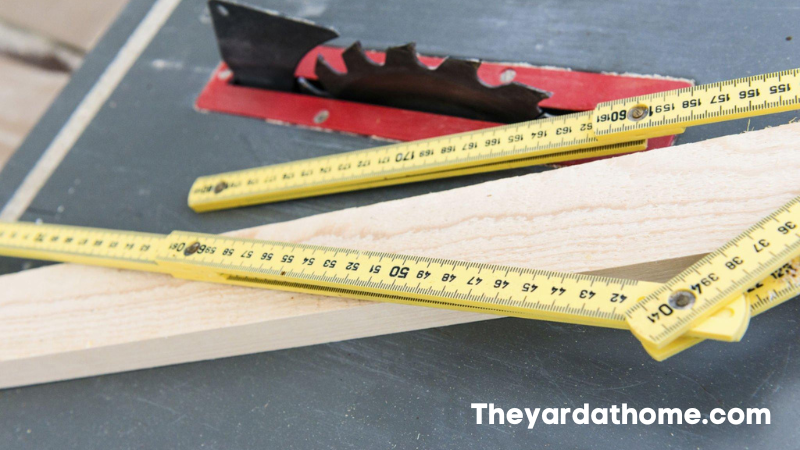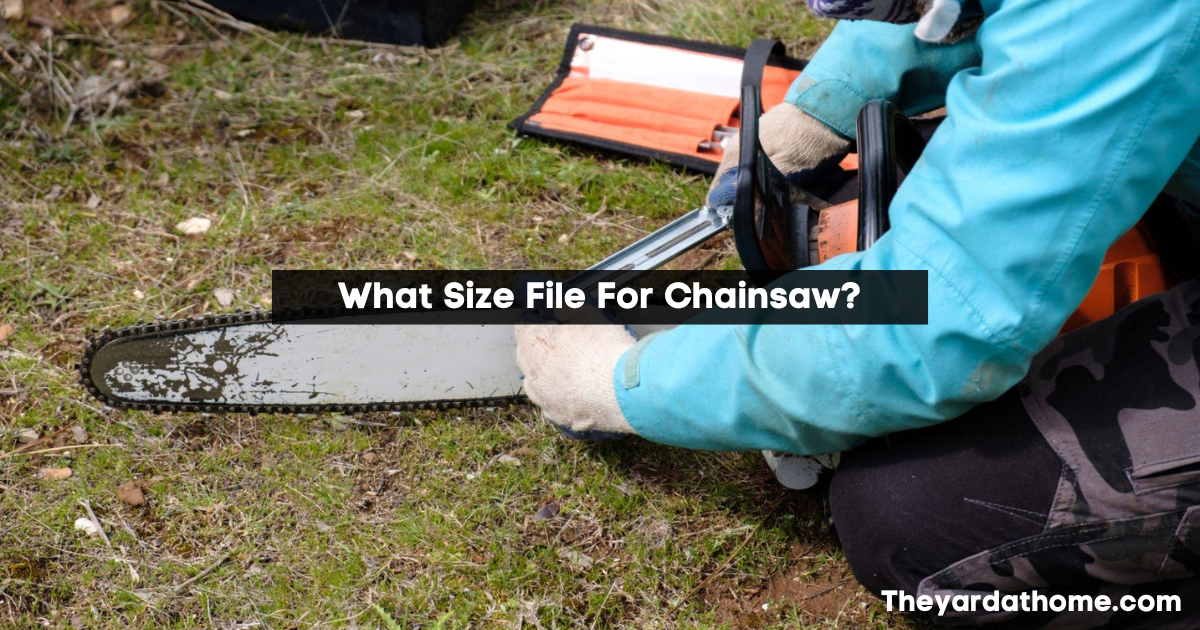Are you tired of your chainsaw dulling after just a few uses? Do you dread the thought of sharpening it yourself? Well, fear no more! With this handy guide, you’ll learn exactly what size file you need to keep your chainsaw sharp and running like a dream.
In this article, we’ll cover everything you need to know about chainsaw files, including the different types, sizes, and how to use them.
We’ll also provide some tips for sharpening your chainsaw like a pro. So whether you’re a seasoned chainsaw user or a complete beginner, this guide has something for you.
File Size
What is the File Size of Chainsaws?
File size refers to the diameter of the round file that fits into the cutting teeth on a chainsaw blade.
Maintaining the sharpness of your saw’s teeth is crucial, ensuring your chainsaw runs smoothly and efficiently.
A file that’s too big or small can lead to uneven teeth, chipping, and other problems that may damage your chainsaw.
| File Size | Chainsaw Pitch |
|---|---|
| 3.5mm | 1/4″ mini |
| 4mm | 1/4″, 3/8″ mini, .325″ mini |
| 4.8mm | .325″ |
| 5.5mm | 3/8″, .404″ |
How to Measure File Size Accurately
Measuring file size is pretty simple; all you need is a calliper. First, clamp the calliper jaws onto the round file at its thickest point. Take note of this measurement in millimetres or inches (depending on your country).
This value represents the diameter of your file and will help you choose which size is appropriate for your chainsaw’s blade. However, be warned that many different sizes are available on the market today, with each one having specific uses for different types of chainsaws.
Some chain models may use larger files than others or require thinner ones for specific tasks such as trimming bark off trees. So always check your chainsaw manual before purchasing or using a new file size.

Factors Affecting File Size Selection
The Impact of Chain Pitch and Gauge on File Size
When selecting the correct file size for your chainsaw, several factors must be considered. One of the most important is the pitch and gauge of your chainsaw chain.
The angle refers to the distance between three consecutive rivets divided by two, while the indicator refers to the thickness of the drive links that fit into the bar groove.
The pitch and gauge of your chainsaw chain significantly affect which file size you should use because different angles and gauges require different-sized files.
Using a file that’s too small or too large for your chainsaw chain will make it difficult to sharpen and lead to poor cutting performance.
Determining Which File Size is Appropriate for Your Chainsaw Model
To determine which file size is appropriate for your specific chainsaw model, you’ll need to consult its owner’s manual or contact the manufacturer directly.
Usually, manufacturers will provide a recommended file size for each model in their product line.
If you need access to an owner’s manual or help to find a recommended file size from the manufacturer, you can use a few techniques to measure your saw chain accurately.
- First, measure across three rivets on your saw chain and divide this number by two, giving you its pitch.
- Then, use callipers or another measuring device to determine your saw chain’s gauge – which should be one-thousandth less than the bar groove width.
- Once you have determined both these measurements, consult a chart provided by most manufacturers or tool suppliers that matches up each combination with an appropriate filing diameter.
- This ensures that when it comes time for maintenance work on your chainsaw, you’ll use precisely the right-sized files needed for optimal cutting performance.
Choosing the Right File Size
Now that we’ve covered what file size means and the factors that affect file size selection, it’s time to dive into how to choose the correct file size for your chainsaw.
Here is a step-by-step guide:
Step 1: Determine Your Chainsaw’s Chain Pitch
The first step in choosing the correct file size is determining your chainsaw’s chain pitch.
This can typically be found in your chainsaw’s user manual or by measuring the distance between three rivets on your saw’s chain.
Step 2: Determine Your Chainsaw’s Gauge
The second step is to determine your chainsaw’s gauge, which refers to the thickness of its drive links.
This can be found in your chainsaw’s user manual or using a calliper measurement tool.
Step 3: Choose The Appropriate File Size
With chain pitch and gauge knowledge, you can now choose an appropriate file size for sharpening your chainsaw blades.
Consult a chart that provides this information based on chain pitch and gauge measurements.

Common Mistakes When Selecting A File Size And How To Avoid Them
Mistakes happen, but here are some common ones people make when selecting a file size:
- Using The Wrong Chart For Reference: Please ensure you use the correct reference chart when selecting a file size. Different chainsaws have different specifications that require different file sizes, so take note of this before consulting any charts.
- Inaccurate Measurements: Inaccurate measurements often lead to incorrect selections of file sizes. Ensure you use precise measurement tools like callipers or rulers and get accurate readings to avoid this mistake.
- Confusing Chain Pitch And Gauge: People often need clarification on chain pitch and gauge, leading to the wrong file size selection. Always double-check your measurements to avoid this error.
By being mindful of these common mistakes, you can easily avoid them and select the correct file size for your chainsaw.
Remember, using the right file size when sharpening your chainsaw blades is crucial for safety reasons. It ensures that your saw runs effectively without causing any accidents.
Maintaining Chainsaw Blades with Proper File Size
Why it’s essential to maintain chainsaw blades with proper filing techniques
Maintaining chainsaw blades is essential for ensuring their longevity and optimal performance.
Filing the edges regularly keeps them sharp, reducing the stress on the engine and minimizing the likelihood of kickbacks or other accidents.
Moreover, using proper filing techniques ensures that each tooth is filed evenly and at the right angle, which enables the saw to cut through wood efficiently.
Tips on maintaining blades with proper filing techniques
To maintain chainsaw blades properly, you should start by cleaning them thoroughly.
- Use a wire brush to remove debris from each tooth and ensure there’s no rust or caked-on dirt.
- Next, determine whether your chainsaw blade has a round or square file size; this will dictate which file you’ll need to use when sharpening it.
- You can then sharpen each tooth individually by holding the file at the correct angle (usually around 25-30 degrees) and running it back and forth across each tooth until you’ve removed all nicks or dull spots.
- Ensure you’re applying even pressure throughout this process, as too much pressure can damage your chain.
When sharpening your chainsaw blade, always work in well-lit conditions with plenty of ventilation; sparks can be dangerous if they come into contact with flammable materials like sawdust.

Conclusion: Prioritize Safety When Choosing a Chainsaw File Size
Choosing the correct file size for your chainsaw is critical to ensure the safety and effectiveness of your cutting tool.
At the same time, it may seem like a small detail, but using the wrong file size can lead to many problems – from dull blades to dangerous kickback incidents. Throughout this article, we’ve discussed how to measure file size accurately, factors that affect file size selection, and how to choose the correct file size for your chainsaw model.
We’ve also highlighted some common mistakes people make when filing their blades and provided tips on maintaining them properly. Remember: prioritizing safety means always using the correct file size when maintaining your chainsaws.

